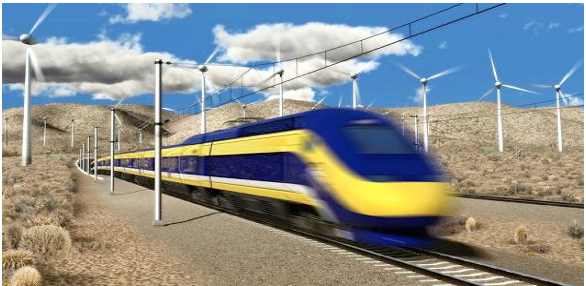CommentsPERSPECTIVE-California has got its own version of a Runaway Train, a 1985 Oscar-nominated movie about escaped convicts who steal a train. It does not end well, as the out-of-control consist hurdles towards a violent end, with the lives of the convicts and their hostages at stake.
The California High Speed Rail Commission is run by the equivalent of convicts who are taking the state’s taxpayers on a ride to a disaster of the financial kind.
Proposition 1A, passed in 2008 by a margin of 5 percentage points, stipulated the following: the train system would have to be financially viable, enable trains to maintain headways of five minutes in each direction, operate without a subsidy, have all construction funds identified for an operating segment before breaking ground and travel between Los Angeles and San Francisco in two hours and 40 minutes.
It has failed on most of these requirements and the others are in doubt.
A blended system that is HSR would have to share tracks with slower freight and current passenger service, would make it very difficult to reach the promised speeds, times and headways, not to mention that freight traffic is harder on the rails, which translates to higher maintenance. If you have ever ridden on shared tracks used by heavy freight, smooth is not the word to describe the ride; delays are a certainty.
Only half the construction costs for the proposed first segment from San Jose to the Central Valley are available. Funding is also challenged by the reliability of cap and trade funds, an important piece of the already anemic available capital.
Also in doubt is the avoidance of an operating subsidy from the government. Technically, that would be enough to kill the project as it would be in clear violation of the bond covenants. It was hinted by a peer review committee that the state might have to make financial guarantees to investors in order to entice them into buying bonds backed by revenue, but that would amount to a commitment to subsidize an operating deficit.
Although Sacramento Superior Court Judge Michael Kenny dismissed a lawsuit aimed at stopping construction, the reason was because there are “too many unknown variables.” In other words, he is not convinced that the project is viable at this stage. His decision appears to err on the side of due process, giving CAHSR time to back up its optimism.
But time is running short for CAHSR to put its money where its mouth is. The lawsuits will continue, cost overruns will pile up and public pressure to kill the project will grow, especially in Southern California and the Central Valley.
If not stopped soon, the people of California will be left with only part of a system, serving only a minority of the population, at a cost much higher than promised for the entire system, as promised in Proposition 1A. According to CAHASR Chair Dan Richard, this is what passes as “delivering what the public voted for.”
(Paul Hatfield is a CPA and serves as President of the Valley Village Homeowners Association. He blogs at Village to Village and contributes to CityWatch. The views presented are those of Mr. Hatfield and his alone and do not represent the opinions of Valley Village Homeowners Association or CityWatch. He can be reached at: [email protected].) Photo: ABC News. Prepped for CityWatch by Linda Abrams.
















